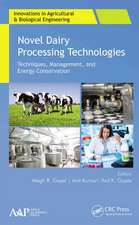Trends in Wheat and Bread Making
Editat de Charis M. Galanakisen Limba Engleză Paperback – 20 noi 2020
- Addresses gluten free products, organic farming and production techniques, enzymatic and biotechnological techniques, fortification of breads with plant by-products, and phenol-rich substrates
- Fills the gap in current resources, focusing on the application of new technologies for processing practices
- Provides a guide to industrial and commercialized applications of innovative breadmaking
Preț: 916.87 lei
Preț vechi: 1183.31 lei
-23% Nou
Puncte Express: 1375
Preț estimativ în valută:
175.48€ • 182.49$ • 146.84£
175.48€ • 182.49$ • 146.84£
Carte tipărită la comandă
Livrare economică 07-21 martie
Preluare comenzi: 021 569.72.76
Specificații
ISBN-13: 9780128210482
ISBN-10: 0128210486
Pagini: 488
Ilustrații: Approx. 100 illustrations
Dimensiuni: 191 x 235 mm
Greutate: 0.83 kg
Editura: ELSEVIER SCIENCE
ISBN-10: 0128210486
Pagini: 488
Ilustrații: Approx. 100 illustrations
Dimensiuni: 191 x 235 mm
Greutate: 0.83 kg
Editura: ELSEVIER SCIENCE
Public țintă
Researchers and industry professionals seeking to produce enhanced bread products through processing-related nutritional and quality improvementsCuprins
1. Introduction to wheat and bread making
2. Ancient wheats in sustainable wheat cultivation
3. Organic farming of wheat & sourdough quality
4. Impact of Preharvest and Controlled Sprouting on Wheat and Bread Quality
5. Ecological parameters influencing microbial diversity and stability of traditional sourdough
6. Role of enzymes in improving the functionality of proteins in non-wheat dough systems
7. Trends of Innovation in Bread and Bakery Production
8. Hydrocolloids in wheat bread making: traditional and novel uses
9. Application of dietary fibers in flour products
10. Oat flour in bread manufacturing
11. Alternatives to increase the antioxidant capacity of bread with phenolics
12. Fortification of bread with wheat processing by-products
13. Innovative Gluten-Free Bread making
14. Rice flour breads
15. Consumer preferences and expectations
2. Ancient wheats in sustainable wheat cultivation
3. Organic farming of wheat & sourdough quality
4. Impact of Preharvest and Controlled Sprouting on Wheat and Bread Quality
5. Ecological parameters influencing microbial diversity and stability of traditional sourdough
6. Role of enzymes in improving the functionality of proteins in non-wheat dough systems
7. Trends of Innovation in Bread and Bakery Production
8. Hydrocolloids in wheat bread making: traditional and novel uses
9. Application of dietary fibers in flour products
10. Oat flour in bread manufacturing
11. Alternatives to increase the antioxidant capacity of bread with phenolics
12. Fortification of bread with wheat processing by-products
13. Innovative Gluten-Free Bread making
14. Rice flour breads
15. Consumer preferences and expectations


























